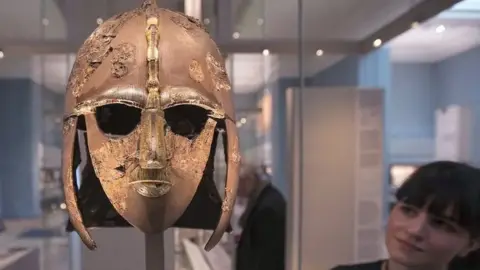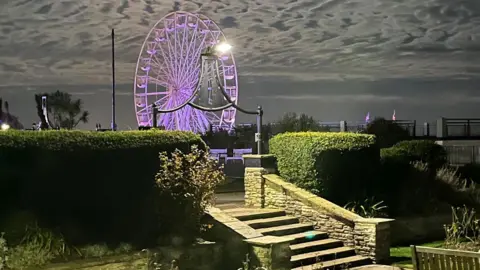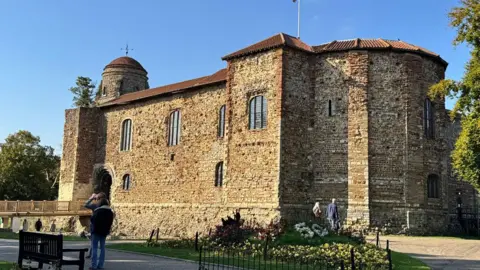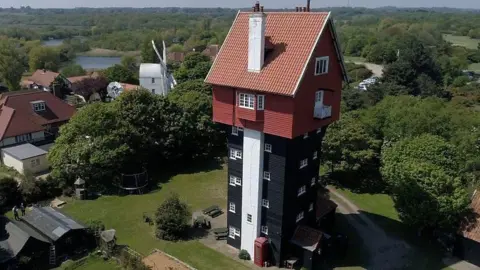What makes East Anglia a 'must see' location?
 Getty Images
Getty ImagesEast Anglia has been named one of the top regions in the world to visit by travel guide Lonely Planet. The region, encompassing Cambridgeshire, Essex, Norfolk and Suffolk, was described as "enigmatic" and praised for its versatility, with its coastline and "timeless villages and lively cities". BBC News explores why it is being shouted about as a location for domestic and international travellers.
Cambridgeshire
 Christopher Hilton/Geograph
Christopher Hilton/GeographCambridgeshire has two of the finest Norman cathedrals in England - Peterborough, the burial place of Tudor queen Katharine of Aragon, and Ely, nicknamed the Ship of the Fens for the way it rises out of the flat, Fen countryside that surrounds it.
Cambridge is best known for its university, punts, museums and lively nightlife, while just outside the city is the Imperial War Museum at Duxford, which showcases military aviation at the site that played a key role in the Battle of Britain.
 PA Media
PA MediaThere are also less well known gems, like the market town of Huntingdon, home to the tiny museum which tells 17th Century statesman Oliver Cromwell's story, and Wisbech, renowned for its stunning Georgian architecture.
The National Trust's Wicken Fen nature reserve offers a glimpse of what the Fenland countryside looked like before it was drained to produce some of England's most fertile soil. It was registered as the most species-rich area of the UK in 2019.
Essex
 Sunny Sim/BBC Weather Watchers
Sunny Sim/BBC Weather WatchersEssex is packed with maritime history, rolling countryside and varied towns, villages and cities.
The quirky seaside resort of Frinton-on-Sea contrasts with busy Clacton-on-Sea and its traditional pier, and the wilder coastline at Mersea Island was the inspiration for award-winning author Sarah Perry's novel Essex Serpent.
 Dammo/BBC Weather Watchers
Dammo/BBC Weather WatchersColchester is home to internationally important Roman archaeology and contemporary visual arts gallery Firstsite - winner of the Art Fund Museum of the Year in 2021, while Chelmsford is considered the birthplace of radio.
And the countryside has some of the prettiest villages in England, including Finchingfield - home to celebrity chef Jamie Oliver - and Great Bardfield, which was the home and inspiration to mid-20th Century artists such as Edward Bawden, Eric Ravilious and textile designer Marianne Straub.
Norfolk
 Walking Tractor/BBC Weather Watchers
Walking Tractor/BBC Weather WatchersNorwich is one of the oldest settlements in England and home to another of the region's fine cathedrals, as well as 33 medieval churches and an 11th Century castle, which is now a museum.
North Norfolk has pretty coastal towns such as Cromer, stunning golden beaches, including Brancaster's, while the fishing port of Great Yarmouth was one of the most important locations for author Charles Dickens' David Copperfield in the years before it became a big Victorian seaside resort.
 Holkham Hall/Instagram
Holkham Hall/InstagramThe Broads National Park is a network of 116 sq miles (303 sq km) of mostly navigable rivers and lakes, offering a haven for wildlife and tourists.
The county is home to some grand stately homes such as Holkham Hall and the Blickling Estate. It also has long-standing Royal connections because of King Charles' private retreat at Sandringham, which was also a favourite home of his late mother Queen Elizabeth.
Suffolk
 Richard Haugh/BBC
Richard Haugh/BBCLandscape artist John Constable was born in 1776 in East Bergholt and the Suffolk countryside was one of his great inspirations - including for his painting, the Hay Wain.
The county's past as a major wool producer led to the development of beautiful towns in Dedham Vale, including Lavenham, home to a 14th Century house used as Harry Potter's birthplace in two of the franchise's films.

Some of Britain's rarest birdlife can be seen at the RSPB's coastal reserve at Minsmere, along a stretch of coastline that includes seaside resorts such as Thorpeness, Southwold and the busy port at Felixstowe.
Cultural offerings include breathtaking Anglo-Saxon treasures uncovered in a ship burial at Sutton Hoo, which featured on Netflix's The Dig, and the vast castle at Framlingham, which was the inspiration for local boy Ed Sheeran's song Castle on the Hill.
The county is home to Aldeburgh Festival, which was founded by composer Benjamin Britten, and the contemporary arts and musical festival Latitude, while Ipswich Town FC recently won promotion to the Premier League.
Follow East of England news on X, Instagram and Facebook: BBC Beds, Herts & Bucks, BBC Cambridgeshire, BBC Essex, BBC Norfolk, BBC Northamptonshire or BBC Suffolk.
